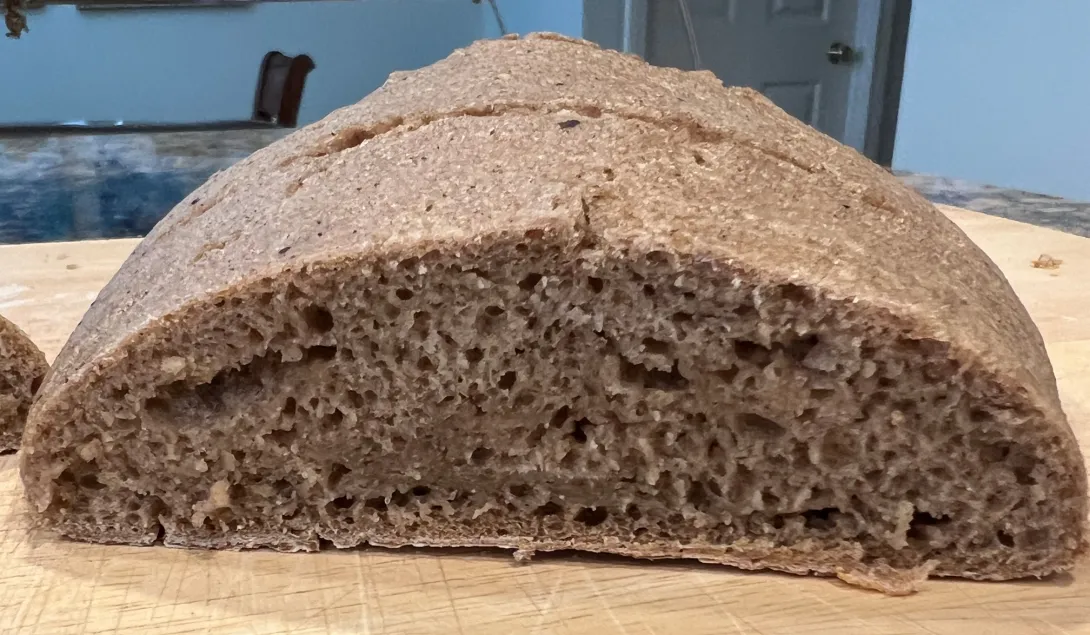
Today's bake: Cumin Rye - Chleb Sandomierski (Poland)
Source: The Rye Baker by Stanley Ginsberg
Notes: Increase hydration from 79.84% to 83.4%
Substitutions: Fresh milled rye @65% extraction for white rye flour.
Discussion: They say you learn more from your failures than from your successes...
I was concerned that the hydration specified in the original recipe wasn't enough for the high quantity (71%) of fresh milled rye flour I used so I increased it by 4% which was too much and resulted in a slack dough and a weak rise when baking. The crust does have a nice bite to it and the crumb is dense with a nice dose of cumin flavor. Although the loaves are sad to look at they do taste good.
Make again? - Probably not
Revised -
Hi Rob,
Reading your comment about the mis-translation for 'cumin' causes me to reevaluate my "Make again? - Probably not" comment.
In eating this bread the cumin taste just wasn't all that compelling but I would probably try it again using caraway. For those whole really like cumin it's worth a try and I would revert to the original hydration level, a reduction of approximately 4%.
Changes/Recommendations: Less hydration! Work on adjusting for fresh milled flour.
*** The Images can be enlarged to full size by placing your cursor on the image and right clicking, and then, open image in a new tab.
Ratings:

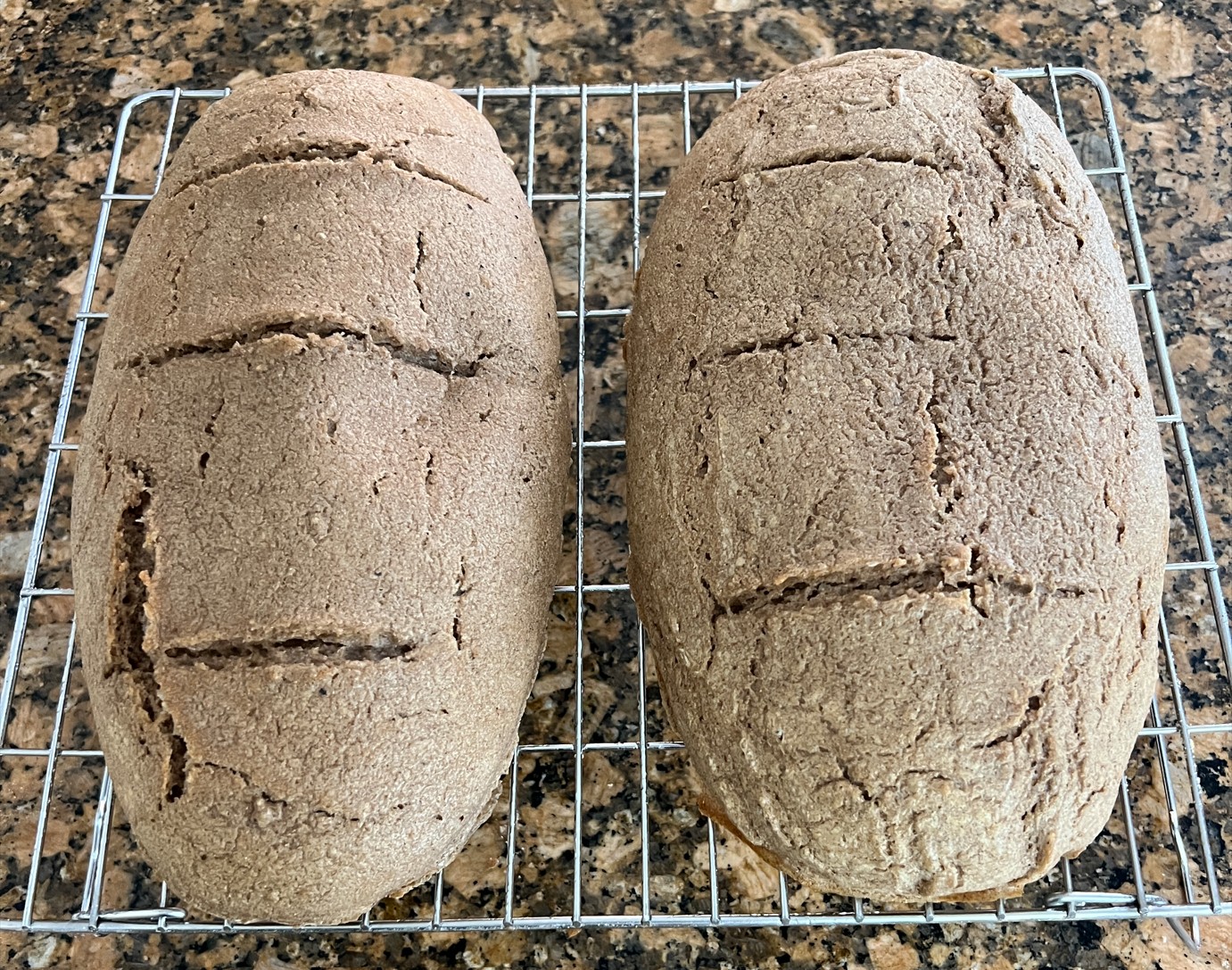
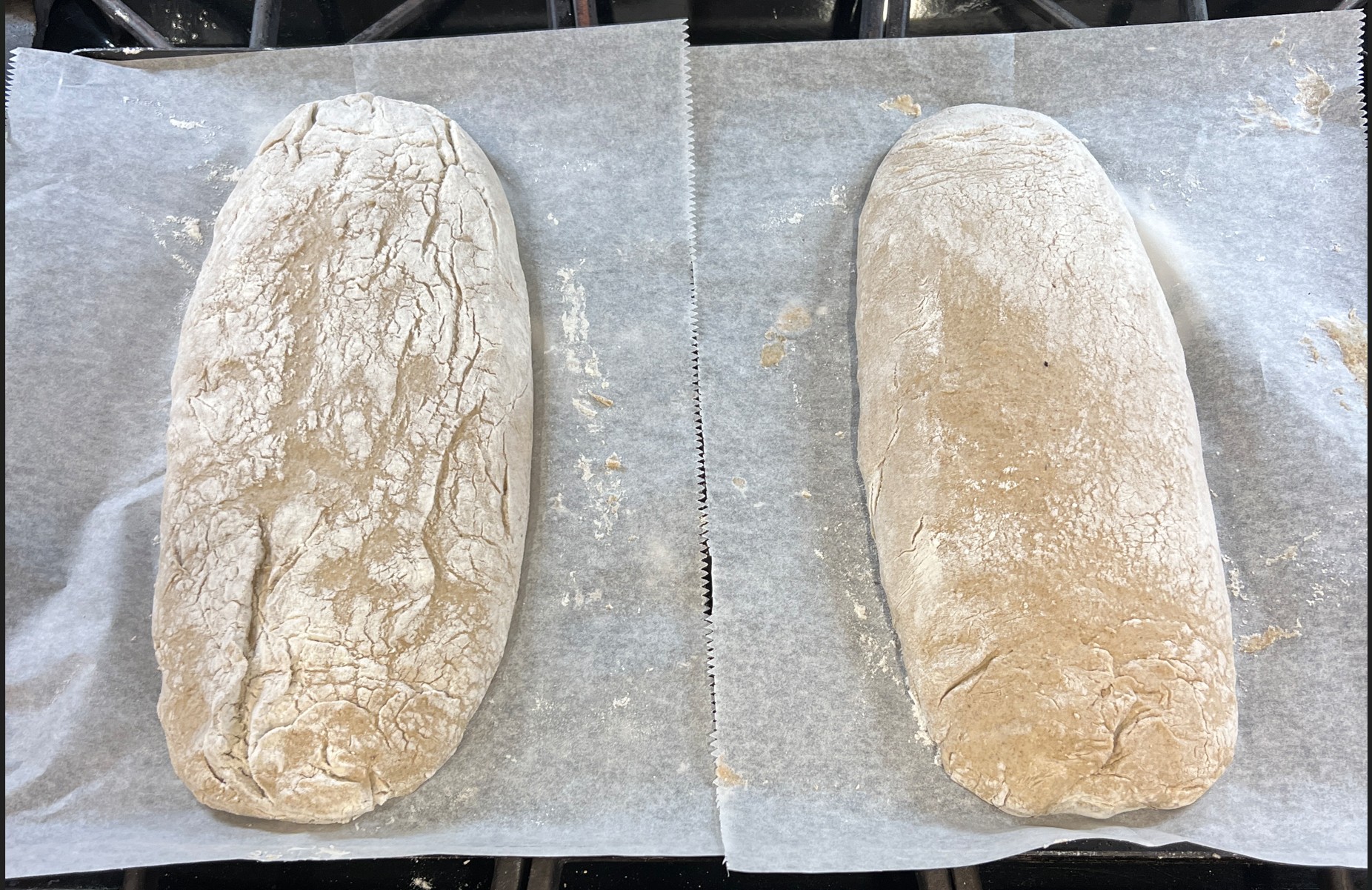
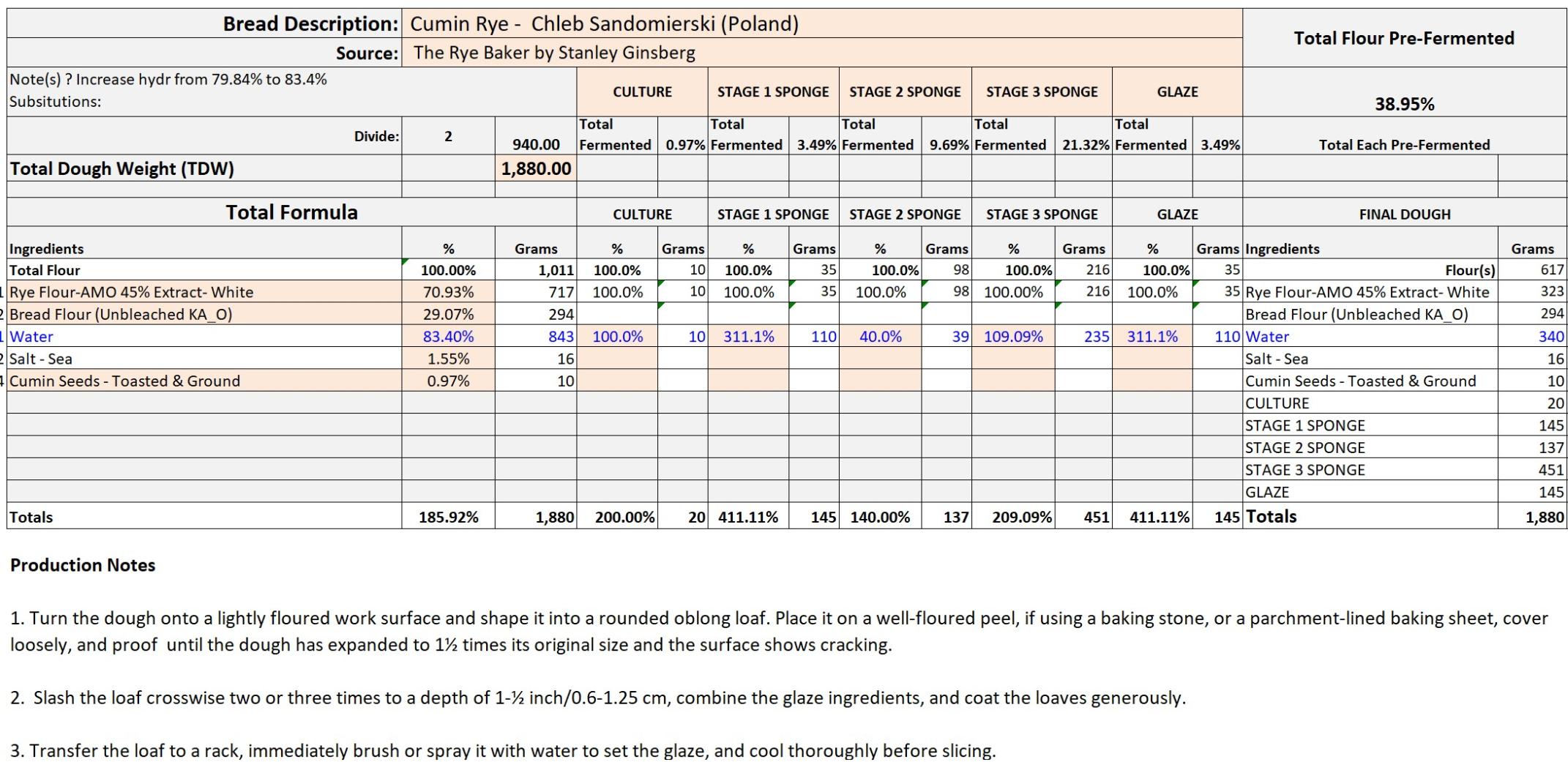
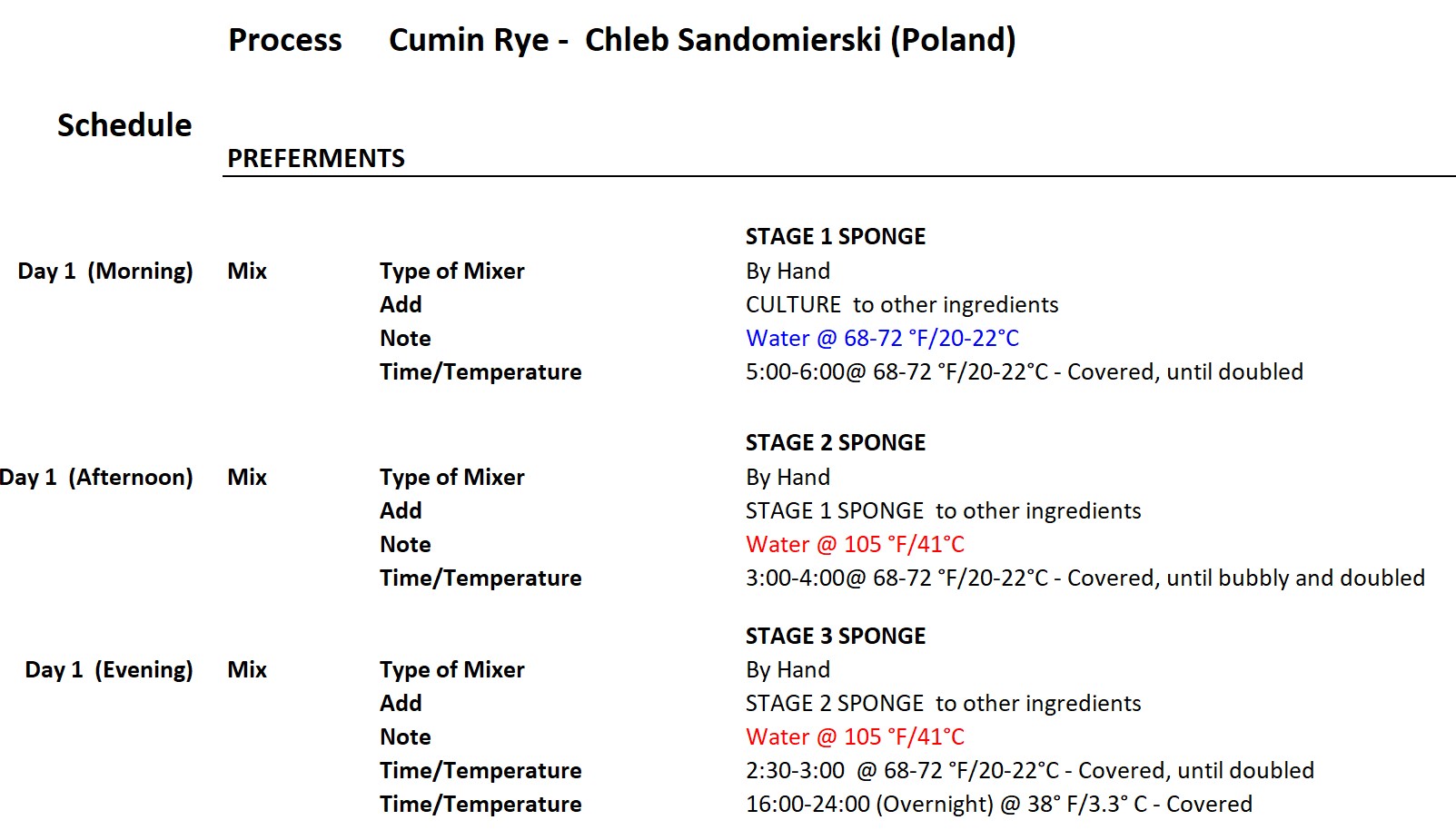
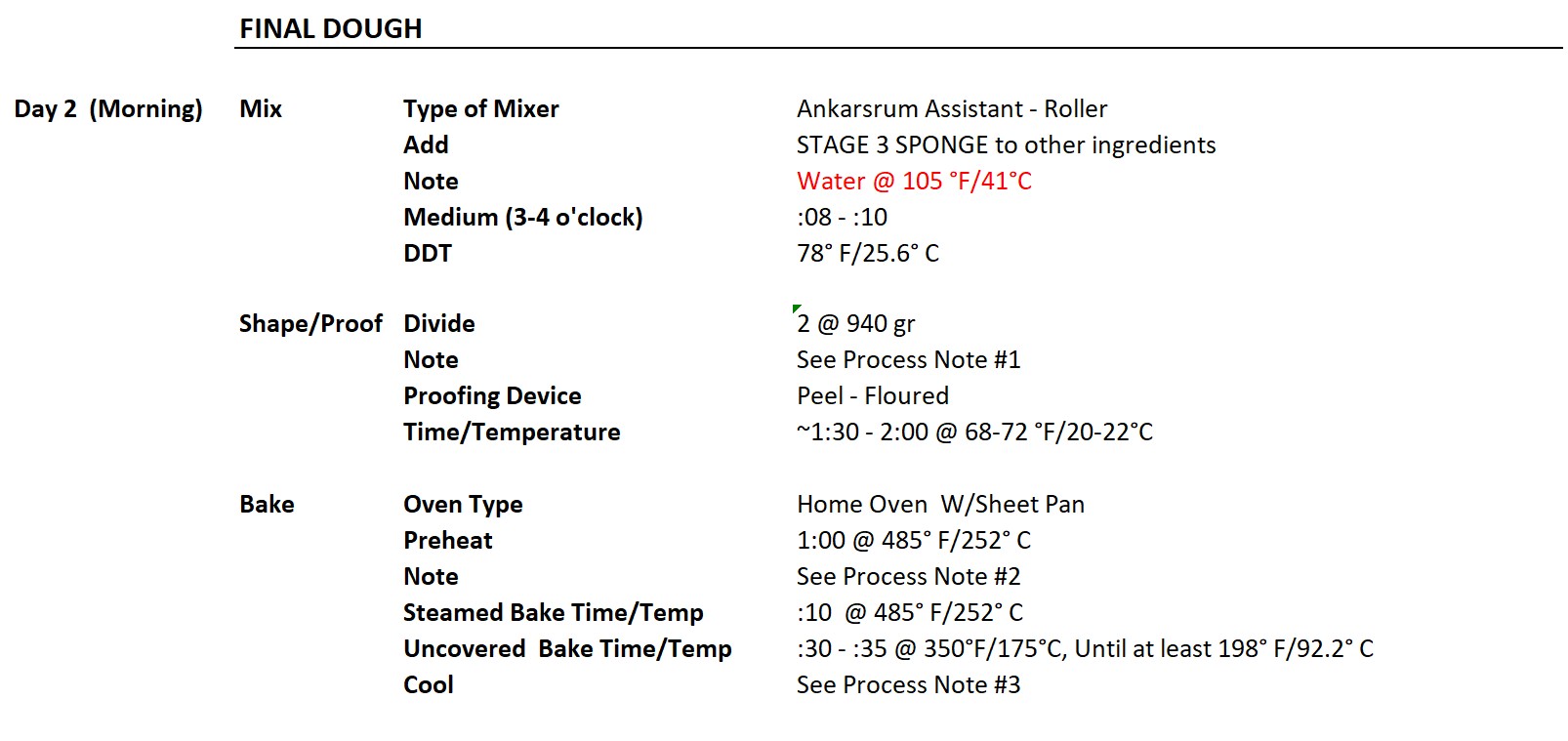
Tony
- CalBeachBaker's Blog
- Log in or register to post comments
wow, Tony: this is the first "Make again? - Probably not" rye I've seen you post. Yet you say it tasted good. Can you elaborate on why you probably won't bake it again?
Rob
PS: I wonder if the cumin in this bread results from an unfortunate mis-translation. In German, kummel is the word for both caraway and cumin -- and this had made for much confusion in otherwise wise bread books. The same may be true in Polish. When I google-translate kminek in online recipes, it comes out cumin. When I google it solo, it comes back translated as caraway.
Hi Rob,
Reading your comment about the mis-translation for 'cumin' causes me to reevaluate my "Make again? - Probably not" comment.
In eating this bread the cumin taste just wasn't all that compelling but I would probably try it again using caraway. For those who really like cumin it's worth a try and I would revert to the original hydration level, a reduction of approximately 4%.
Tony
Still isn't even if more people know about it nowadays. Kminek is caraway. It doesn't have another meaning. Not sure where those mistranslations originate. Maybe something like "tea leaves" appearing in bread recipes translated from Russian? Although I like cumin and enjoy using it in the ethnic recipes that call for it, it is out of place in Polish cuisine and breads and I don't know of a single recipe calling for it. I found original recipe for "chleb sandomierski" and it calls for caraway. As does a bunch of other Polish breads. Ginsberg mistranslated it and is certainly wrong on this one even though he may have defended that. When I first saw that recipe I did a double take. I never heard of cumin before coming to the US. So I made the bread with caraway, as tradition dictates, and it was good. But then again, I like caraway. However, the so called "jewish deli rye" (which may have evolved from breads such as sandomierski) that's commonly sold in the supermarkets has way too much caraway. Not a fan. Ginsberg's or Hamelman's versions are much better.
Breadzik - thanks for the information on Polish cuisine. I'm going to update my formula using caraway seed.
Tony
If you want to go to the source, check the link I provided to Adam Piekarz blog. Let me know if you have any questions.
Thanks, Breadzik, for the confirmation.
BTW: In certain NYC neighborhoods, you could get into a bar fight for saying 'too much caraway in the rye.' But I agree with you. When I knocked back caraway to 1% in my deli ryes, the breads became much better. You could taste the rye. Any more and all you taste is caraway. (2 caveats: 1st, I've seen posts on Hamelman's and Ginsberg's versions that veer between 1.2% and 1.7% caraway -- so they use quite a bit more than I do. And, 2nd, whenever I share a rye with my father, who grew up on NYC deli rye when it was good, he asks, 'is there any caraway in this?' I think he craves caraway bread, with a touch of rye added.)
Rob
Some people have strong opinion about that even if, reading up on history of the deli rye, it went on a journey from "more rye character/less caraway flavor" to "more caraway character/less rye flavor". Anyhow, original sandomierski recipes call for 0.15 - 0.2% caraway. Adam Piekarz has a very good recipe. This one uses a three stage sourdough method just like it would be done in bakeries and also specifies the correct temperatures for the stages. When I had the page translated, "kminek" came out as "cumin" but it should be "caraway". And he calls for 1% in this recipe.
It is very interesting reading.
Did have a laugh with the translation of
Wypiekaj z zaparowaniem 5 minut w 220-230oC i dalej 35 minut w temp 180-190oC.
To
"Bake with constipation 5 minutes in 220-230o o oC.."
-Jon
That's funny. But, yeah, that one is "Bake with steam". I'm not even sure where those translators get their dictionaries from. They're off the mark completely sometimes. If you feel like it you can play with the DeepL translator. It at least translated "kminek" as "caraway seed".
If you have any questions about the recipe just let me know. FYI, he also posted other traditional recipes on the blog. I found this to be the best Polish bread blog out there, though, sadly, he hasn't updated it in years. Still, it's the best source for traditional Polish bread recipes as they would be made in bakeries according to the official standards. All the other Polish blogs look like just copies of this one.
Just one thing to note: the water temperature that he specifies for a stage is actually the DDT for that stage. He clarified that in one of the comments.
Unless I missed it, he doesn't actually mention how he makes the paste or glaze that is applied on top before baking (the translation calls it a gruel). I do love the traditional look it gives, never mind how it improves the crust.
Thanks Breadzik!
"Teraz przygotuj kleik z mąki żytniej typ 720 oraz wody. Po pełnym rozroście ciasta (tuż przed wstawieniem do rozgrzanego piekarnika) posmaruj je przy pomocy pędzla kleikiem."
Firefox's (even though it's my favorite browser) translation sucks, but DeepL gives a much better result:
"Now prepare the gruel from rye flour type 720 and water. After the dough is fully expanded (just before you put it in the preheated oven), brush it with the gruel using a brush."
The "gruel" is just light or white rye flour mixed with some cold water. Like one would prepare corn starch.
Many thanks, much appreciated
Thanks for highlighting the Adam Piekarz blog and the cumin problem in The Rye Baker. I found the blog a couple of years ago when I was looking for Polish bread recipes. As I was looking at the site, I realized that nearly the entire chapter of Polish bread recipes in The Rye Baker came from there, often with no changes.
I am still puzzled how Ginsberg got cumin/caraway mixed up. A little digging would have revealed that cumin was just not used in Polish, Baltic, or Russian breads. I also am surprised that he didn't discuss the actual fermented rye malt that is found in many Baltic, Russian, and some German breads. He describes the process for toasting rye malt but does not say that it is only a substitute if you can't find the fermented rye malt. The toasted rye malt (or crystal rye malt) is appropriate for some Finnish breads, though, as far as I can tell.
Ginsberg lifted some other recipes as well. And I don't mean that as a knock against him but at least he could've included the proper temperatures. But then again, I'm just a stickler for precision and, at least according to master bakers from Poland, proper sourdough treatment is paramount to rye baking even if it may be difficult for home bakers to achieve. That information could be provided as Hamelman proved in publishing the Detmolder recipes. Rye is life. Even if the instructions aren't exactly followed. I'm just happy to own this book as it is such a great resource and puts so many varied rye based recipes together along with general rye baking knowledge and just hope there is a corrected/expanded edition including that information as I love rye. There is nothing like a properly made rye loaf. I'd happily pay for it again. Even more so for part two ("The Advanced Rye Baker" anyone?) as there is even more rye baking lore not even mentioned: CLAS, fermented rye malt, baking on leaves. Still, this book is a great resource for rye baking but I'm looking for more. I love rye. Did I mention that? I'm just hungry for the next rye loaf.
Rye Zwei?
Sorry, I have no idea. Is that German or something?
you got it! Rye 2, Rye 3. Like movie sequels. I'm all in on more rye books. -- Rob
Thanks! Yeah, rye seems to be severely underrepresented in English language literature. I'm collecting the crumbs wherever I can.
completely agreed. I'd be interested in a book that included history, with stuff on ergot -- the common rye fungus. Some historians believe that crazed visions caused by eating lots of moldy rye bread caused the medieval craze of St. Vitus Dance and the quasi-hallucinogenic paintings of Bosch and the Breugels. Others have suggested ergot was responsible for the visions recounted in the Salem Witch Trials. Maybe it's still impacting us?
The Rye Baker does delve briefly into the history of rye cultivation and has some info on ergot/ergotism and its neurological effects.
as it is written: 'Let no man bake the bread of understanding without the help of constipation.'
Rye or otherwise. Though without the constipation part. Can't say ever had an issue and whole grain rye has always been my favorite. Good eating.
That's exactly what it is, a mistranslation. Polish for caraway is indeed kminek, and it's routinely translated incorrectly. The rule of thumb is it's always caraway.
I can see how that would be confusing if cumin means something else in Polish. Hopefully you try it again and enjoy the flavour more.
Benny
but if you said that to someone in Poland they would look at you like you were from another planet. It's just not very well known, though with opening of the borders and markets it's available now for those who seek it. However, "kminek (caraway)"? Everybody knows "kminek".
Thanks Benny
I will at some point give it a redo, for now more rye breads from Stanley's book in planning.
Tony
I tried it ... from Adam Piekarz' formula ... with caraway not cumin ... and it's delicious
mods:
Conclusions:
Rob
A super-looking loaf, Rob! Did the caraway flavor come through strongly?
TomP
thanks, Tom. At 1%, the caraway is present and pleasant. -- Rob
Yowzers Rob, lovely bread!
I'm taking note of your mods, because normally I do what you do, and good white rye flour needs a good Polish supermarket.
Also fascinated to learn that your partner doesn't like high ryes normally and they're so much your thing. Although, I guess my wife only eats gluten free (but she'll have a taste of a wheat bread).
-Jon
Thx Jon. The way I made this, the rye mix was about 50/50 white/whole. If I only had whole rye, I might think to use a slightly higher percentage of all purpose or bread flour in the final dough.
As for my partner -- it's de gustibus non est disputandum. The day before yesterday, she remarked, "the better you get at making bread, the worse your breads get." ... yet, in the end, she's who I bake for, so it's all good.
Rob
And this entire time, I thought you were a guy 😂 my bad!
Jay
I'm pretty confused sometimes myself.
I think the 3-stage levain process deepens the rye flavor beyond what I usually get with a single-stage deli rye -- though it's probably time for a side-by-side taste test.
Rob
Still got it Rob!
And I trust you actually will do a side-by-side taste comparison somehow, if I recall that could be your style.
-Jon
thanks, Jon. It's nice to know I have a style. 🙌🏻
Rob
for a friend
Rob